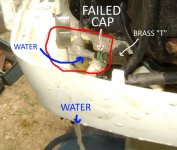1988 Johnson 225 (VRO removed)
Model #J225TXCCE
Ser. # G 7745885
I searched all the archives & the internet beforehand....
I haven't run this motor in 8 years, and when I did last time (2008), it was only for an hour & it ran great!. I had JUST purchased the motor USED from a Dealer, to replace my old worn out 1986 Johnson 175 VRO! (I kept the 175 as the lower unit is a spare for this 225 should it ever encounter ROCKS!)
This "new" motor says "VRO" on cover, however all the VRO had been removed, prior to my purchase. I mix 50:1 when filling & have a water separator.
BEFORE starting, I added fresh fuel & squeezed all the old fuel from the line. I checked the water separator and I checked the 2 overheat alarms on the cylinder heads by grounding out the sender wires= checked good!
I ran the engine for a minute or so, removing (then replacing) all the water cooling lines to be sure they were all clear of mud, bugs, etc..
As a result...I have 3 questions:
1) What is this check valve for? I wasn't getting any water from this line, so I sucked on it (engine off) and a BUG landed in my mouth.... THEN, I heard water draining from inside the engine (after I'd run it for a minute or so).

2) I replaced this FAILED cap? Starboard aft lowest side of engine has a brass T with what looked like a FAILED Zip-tied CAP? It started SPRAYING water at the exact time the "pisser tube" does. Except.... it was filling up the engine cowling. I could not find any cooling hose diagrams for this engine?
Why is there a cap on it? Is this because the VRO was removed, & this had something to do with that? That doesn't make sense?

3) When I turn my ignition key to the "on" position, I do NOT get "the alarm" that I assume is a pre-test for the audio of the alarm itself?
I don't recall if I ever had it before with the '86 Johnson 175, nor when I ran this "new" '88 225 motor back in 2008? The boat & it's previous 175
are both 1986. Did they have the alarm key "on" test back in 1986?
Thank you for your help!
jonny

P.S. The motor runs outstanding, except for a small fuel leak at carb's where an in-line black plastic "T" was cracked. I am replacing that T today.
P.S.S. This is sort of a double post, as I started a thread in the "Identifying Model/ Year / Horsepower" sub-forum, however these questions don't apply there anymore?
Model #J225TXCCE
Ser. # G 7745885
I searched all the archives & the internet beforehand....
I haven't run this motor in 8 years, and when I did last time (2008), it was only for an hour & it ran great!. I had JUST purchased the motor USED from a Dealer, to replace my old worn out 1986 Johnson 175 VRO! (I kept the 175 as the lower unit is a spare for this 225 should it ever encounter ROCKS!)
This "new" motor says "VRO" on cover, however all the VRO had been removed, prior to my purchase. I mix 50:1 when filling & have a water separator.
BEFORE starting, I added fresh fuel & squeezed all the old fuel from the line. I checked the water separator and I checked the 2 overheat alarms on the cylinder heads by grounding out the sender wires= checked good!
I ran the engine for a minute or so, removing (then replacing) all the water cooling lines to be sure they were all clear of mud, bugs, etc..
As a result...I have 3 questions:
1) What is this check valve for? I wasn't getting any water from this line, so I sucked on it (engine off) and a BUG landed in my mouth.... THEN, I heard water draining from inside the engine (after I'd run it for a minute or so).
2) I replaced this FAILED cap? Starboard aft lowest side of engine has a brass T with what looked like a FAILED Zip-tied CAP? It started SPRAYING water at the exact time the "pisser tube" does. Except.... it was filling up the engine cowling. I could not find any cooling hose diagrams for this engine?
Why is there a cap on it? Is this because the VRO was removed, & this had something to do with that? That doesn't make sense?

3) When I turn my ignition key to the "on" position, I do NOT get "the alarm" that I assume is a pre-test for the audio of the alarm itself?
I don't recall if I ever had it before with the '86 Johnson 175, nor when I ran this "new" '88 225 motor back in 2008? The boat & it's previous 175
are both 1986. Did they have the alarm key "on" test back in 1986?
Thank you for your help!
jonny
P.S. The motor runs outstanding, except for a small fuel leak at carb's where an in-line black plastic "T" was cracked. I am replacing that T today.
P.S.S. This is sort of a double post, as I started a thread in the "Identifying Model/ Year / Horsepower" sub-forum, however these questions don't apply there anymore?

